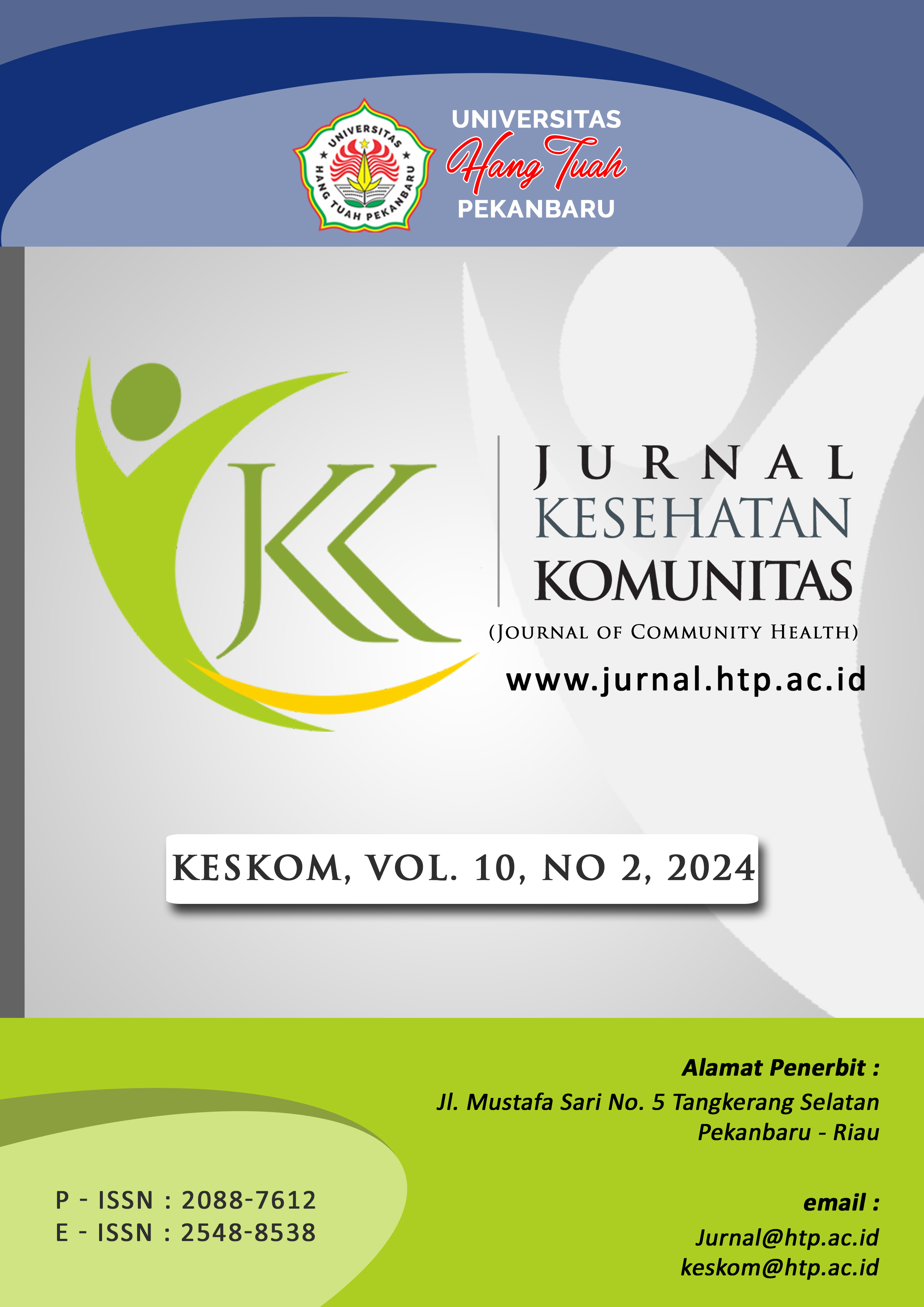The Relationship of Preconcetional Health Knowledge with Results of ELSIMIL Application Screening for Prospective Brides
DOI:
https://doi.org/10.25311/keskom.Vol10.Iss2.1903Abstract
Stunting is a condition of growth failure in children with short bodies that do not match their developmental age, the cause of which can be identified from the preconception period through the ELSIMIL application screening. The research aimed to determine the relationship between preconception health knowledge and the results of ELSIMIL application screening for prospective brides and grooms. Cross-sectional research design with a sample of 106 prospective bride and groom respondents who were recorded as having applied ELSIMIL in three sub-districts of Padang City (Koto Tangah, Padang Timur, and Padang Selatan). The research was conducted from January-May 2024 and the analysis techniques were univariate, bivariate (chi-square test), and multivariate (multiple logistic regression test). The results of the analysis show that there is a relationship between preconception health knowledge (p=0.000), employment (p=0.001), and income (p=0.003) and there is no relationship between education (p=0.432) and the results of the ELSIMIL application screening as well as the most dominant factor. related is preconception health knowledge with an OR value of 13.754. This research concludes that preconception health knowledge is the main factor influencing ELSIMIL application screening results for prospective brides and grooms.
Downloads
References
1. UNICEF. (2023). Level and trend in child malnutrition. New York: United Nations Children’s Fund
2. Wake. S. K., Zewotir, T., Lulu, K. & Fissuh, Y. H. (2023). Longitudinal trends and determinants of stunting among children aged 1 – 15 years. BMC. 81(60), 1–12. https://doi.org/10.1186/s13690-023-01090-7 DOI: https://doi.org/10.1186/s13690-023-01090-7
3. Kemenkes RI. (2023). Petunjuk Teknis Pemberian Makanan Tambahan (PMT) Berbahan Pangan Lokal untuk Balita dan Ibu Hamil. Kementerian Kesehatan RI. Jakarta, Indonesia
4. Dinas Kesehatan. (2023). Profil Kesehatan Kota Padang Tahun 2022. Dinas Kesehatan Kota Padang. Padang. Indonesia
5. Achadi. E. L., Aninditha. T., Malik. S. G., Sekartini. R., Agustina. R., Farsia. L., Kusharisupeni., Pusponegoro. H. D., Jalal. F., Tahapary. D. L., Utari. D. M., Setiarini. A., Syam. A. F., Achadi. A., Thaha. A. R. & Putra. W. K. Y. (2020). Pencegahan Stunting Pentingnya Peran 1000 Hari Pertama Kehidupan. Depok, Indonesia, Rajawali Pers
6. Uwiringiyimana, V., Osei, F., Amer, S. & Veldkamp, A. (2022). Bayesian geostatistical modelling of stunting in Rwanda: risk factors and spatially explicit residual stunting burden. BMC Public Health. 22(159), 1-14. https://doi.org/10.1186/s12889-022-12552-y DOI: https://doi.org/10.1186/s12889-022-12552-y
7. Ni’mah, C. & Muniroh, L. (2015). Hubungan Tingkat Pendidikan, Tingkat Pengetahuan dan Pola Asuh Ibu dengan Wasting dan Stunting pada Balita Keluarga Miskin. Media Gizi Indonesia. 10(1), 84–90. DOI: https://doi.org/10.20473/mgi.v10i1.84-90
8. Notoadmodjo, S. (2012). Promosi Kesehatan dan Perilaku Kesehatan. Jakarta, Indonesia, Rineka Cipta
9. PERPRES. (2021). Peraturan Presiden No. 72 Tahun 2021. Presiden Republik Indonesia. Jakarta, Indonesia
10. Novita, F., Sikmiyati, C., Sopari, A. & Murwanto. R. (2022). Modul Aplikasi ELSIMIL (Elektronik Siap Nikah dan Hamil) Bagi Tim Pendamping Keluarga. Badan Kependudukan dan Keluarga Berencana Nasional. Jakarta, Indonesia
11. Atamou, L., Rahmadiyah, D. C., Hassan, H. & Setiawan, A. (2023). Analysis of the Determinants of Stunting among Children Aged below Five Years in Stunting Locus Villages in Indonesia. Healthcare.11(810).1–12. https://doi.org/10.3390/ healthcare11060810 DOI: https://doi.org/10.3390/healthcare11060810
12. Barbosa, L. B., Vasconcelos, S. M. L., Correia, L. O. dos S. & Ferreira, R. C. (2016). Nutrition Knowledge Assessment Studies in Adults: A Systematic Review. Cien Saude Colet. 21(2). 449–62. https://doi.org/10.1590/1413-81232015212.1 DOI: https://doi.org/10.1590/1413-81232015212.20182014
13. Lestari, P. (2020). Hubungan Pengetahuan Gizi, Asupan Makanan dengan Status Gizi Siswi Mts Darul Ulum. Sport and Nutrition Journal. 2(2). 73–80. https://journal. unnes.ac.id/sju/index.php/spnj DOI: https://doi.org/10.15294/spnj.v2i2.39761
14. Melani, V. & Kuswari, M. (2019). Pengetahuan Gizi Seimbang Calon Pengantin Di Beberapa Kantor Urusan Agama Jakarta Barat. Darussalam Nutrition Journal. 3(1). 1–6. https://doi.org/10.21111/dnj.v3i1.3030 DOI: https://doi.org/10.21111/dnj.v3i1.3030
15. Dennis, C.-L., Brennenstuhl. S., Brown. K.H., Bell. R. C., Marini F. & Birken. C. S. (2021). High-risk Health Behaviours of Pregnancy-planning and Men: Is there a need for Preconception care? Midwifery. doi:10.1016/j.midw.2021.103244 DOI: https://doi.org/10.1016/j.midw.2021.103244
16. Khairani, N. & Effendi, S. U. (2019). Family characteristics as risk factors of stunting among children age 12-59 month. Jurnal Airsyah : Jurnal Ilmu Kesehatan. 4(2). 119–130. https:/ / aisyah.journalpress.id/ index.php/ jika/ DOI: https://doi.org/10.30604/jika.v4i2.188
17. Morakinyo, O. M., Adebowale, A. S., Obembe, T. A. & Oloruntoba, E. O. (2020). Association between household environmental conditions and nutritional status of women of childbearing age in Nigeria. PLoS One. 15(12). 1–15. https://doi.org/ 10.1371/journal.pone.0243356 DOI: https://doi.org/10.1371/journal.pone.0243356
18. Islam, A., Islam, N., Bharati, P., Aik, S. & Hossain, G. (2016). Socio-economic and demographic factors influencing nutritional status among early childbearing young mothers in Bangladesh. BMC Women's Health. 16(58). https://doi.org/10.1186/s12905-016-0338-y DOI: https://doi.org/10.1186/s12905-016-0338-y
19. Indriyani, S., Kusharisupeni & Adawiyah, A. R. (2024). Determinan Anemia pada Remaja Putri. Jurnal Ilmu Kesehatan Masyarakat. 13(2). 149–157. http://journals.stikim.ac.id/index.php/jikm DOI: https://doi.org/10.33221/jikm.v13i02.2709
20. Mutingah, Z. & Rokhaidah, R. (2021). Hubungan Pengetahuan Dan Sikap Ibu Dengan Perilaku Pencegahan Stunting Pada Balita. Jurnal Keperawatan Widya Gantri Indonesia. 5(2). https://doi.org/ 10.52020/jkwgi.v5i2.3172 DOI: https://doi.org/10.52020/jkwgi.v5i2.3172
21. Marume, A., Archary, M. & Mahomed, S. (2023). Predictors of stunting among children aged 6 – 59 months, Zimbabwe. Public Health Nutrition. 26(4). https://doi.org/10.1017/S1368980023000046 DOI: https://doi.org/10.1017/S1368980023000046
22. Ernawati, A. (2018). Hubungan Usia dan Status Pekerjaan Ibu Dengan Kejadian Kurang Energi Kronis Pada Ibu Hamil. Jurnal Litbang. XIV(1). 27-37. https://doi.org/10.33658/jl.v14i1.106 DOI: https://doi.org/10.33658/jl.v14i1.106
23. Sinaga, N. A. B. & Adi, A. C. (2023). Hubungan Ketahanan Pangan Rumah Tangga Nelayan Dengan Status Gizi Ibu Wanita Usia Subur (WUS) DI Kabupaten Brebes. Healthy Tadulako Journal. 9(3). 375-381. https://doi.org/10.22487/htj.v9i3.1017
24. Nshimyiryo. A., Hedt-Gautheir. B., Mutaganzwa. C., M. Kirk. C., Beck. K., Ndayisaba. A., Mubiligi. J,. Kateera, F. & El-Khatib. Z. (2019). Risk factors for stunting among children under five years: A cross-sectional population-based study in Rwanda using the 2015 Demographic and Health Survey. BMC Public Health. 19(175). 1-10. https:/doi.org/10.1186/s12889-019-6504-z DOI: https://doi.org/10.1186/s12889-019-6504-z
25. Asgedom. Y. S., Seifu. B. L., Mare. K. U., Asmare. Z. A., Asebe. H. A., Kase. B. F., Shibeshi. A. H., Tebeje. T. M., Sabo. K. G., Fente. B. M., Kassie. G. V. & Lombebo. A. A. (2024). Levels of stunting associated factors among under-five children in Ethiopia: A multi-level ordinal logistic regression analysis. PLoS One. 19(1). 1–13. https://doi.org/10.1371/journal.pone.0296451 DOI: https://doi.org/10.1371/journal.pone.0296451
26. Guirindola, M. O., Goyena, E. A. & Maniego, M. L. V. (2021). Risk factors of stunting during the complementary feeding period 6-23 months in the Philippines. Malaysian Journal of Nutrition. 27(1). 123-140. https://doi.org/10.31246/mjn-2020-0112 DOI: https://doi.org/10.31246/mjn-2020-0112
27. Yohana, B. & Oktanasari, W. (2022). Hubungan Antara Pendapatan Dengan Usia Pernikahan Dini Pada Remaja Di Kelurahan Tanjung Kecamatan Purwokerto Selatan kabupaten Banyumas. Jurnal Bina Cipta Husada. XVIII(1). 67–79. https://jurnal.stikesbch.ac.id/index.php/jurnal/article/view/55
28. Kartini. (2023). Faktor-faktor yang Berhubungan Dengan Kejadian Anemia Pada Remaja Putri. Jurnal Kesehatan Unggul Gemilang. 7(12). 64–71. htts://doi.org/10.3100
29. Marlinda, L. (2023). Hubungan Peran Tenaga Kesehatan, Pengetahuan Dan Status Ekonomi Terhadap Perilaku Pencegahan Kek Pada Catin Di Upt Puskesmas Bojonegara Tahun 2022. SENTRI: Jurnal Riset Ilmiah. 2(6).1917–1929. https://ejournal.nusantaraglobal.ac.id/index.php/sentri DOI: https://doi.org/10.55681/sentri.v2i6.979
Downloads
Submitted
Accepted
Published
How to Cite
Issue
Section
License
Copyright (c) 2024 Jurnal kesehatan komunitas (Journal of community health)

This work is licensed under a Creative Commons Attribution-NonCommercial-ShareAlike 4.0 International License.
Copyright @2017. This is an open-access article distributed under the terms of the Creative Commons Attribution-NonCommercial-ShareAlike 4.0 International License (http://creativecommons.org/licenses/by-nc-sa/4.0/) which permits unrestricted non-commercial used, distribution and reproduction in any medium












































